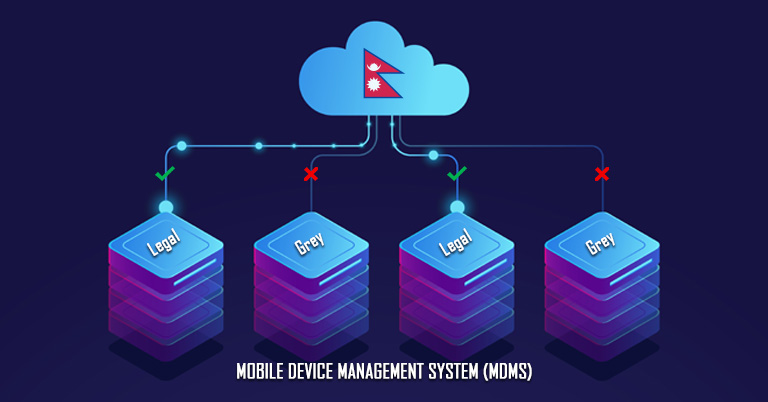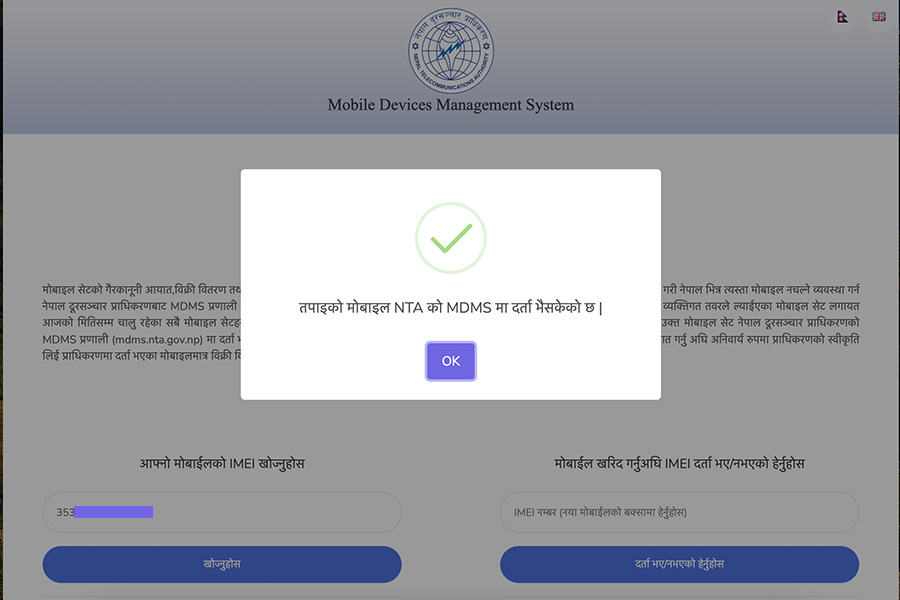
After a lot of back-and-forth, NTA (Nepal Telecommunications Authority) implemented MDMS (Mobile Device Management System) in Nepal from the 7th of Nov, 2023 (Kartik 21, 2080). Initially, NTA had blacklisted 2500 units of the grey iPhone 15 series with more to follow. Let’s learn more about the actual truth and fuss about MDMS going LIVE in this article today.
What is a Mobile Device Management System (MDMS) in Nepal?
MDMS is a centralized government-owned system to keep a record of any phones and similar electronic accessories that enter the country — via their unique IMEI number(s). This includes smartphones, feature phones, bar phones, tablets, etc. So, basically any gadget with SIM. After its implementation:
- Phones not registered at NTA (illegal/grey imports) will be blocked from any and all carrier networks (NTC, Ncell) in Nepal.
- This means that you will be able to use other functions of the phone like connecting to WiFi, streaming videos, etc. but making/taking phone calls and messages won’t be possible.
- Think of it as iPhone vs iPod Touch. iPhone is how your unregistered device is right now whereas it’ll transform to iPod Touch once MDMS goes live. No cellular connectivity while everything else you’d expect from a smartphone will work perfectly fine.
- And if and when you lose such phones, you won’t be eligible to file a police complaint either. On the other hand, Nepal Police and other concerned authorities can help you track your lost or stolen phones if they are registered under MDMS.
As… MDMS went LIVE on the 21st of Kartik!
After strings of delays, MDMS went live nearly 1.5 months back. An official statement from the Nepal Telecommunication Authority (NTA) stated the full implementation of MDMS. Starting from Kartik 21 (Nov 7, 2023), NTA commenced the blacklisting of premium smartphones, which turns out to be 2500 grey units of the iPhone 15 series.
For a quick recall, NTA did send a 15-day preliminary notice marking the 15-day deadline for grey phones. Although, it had denied registration in the beginning, you can actually register blacklisted phones at least for now.
Ncell and NTC Blocking Grey Phones Network
After the blacklisting by NTA, Ncell sent a text message and calling its blacklisted customer. They are requesting you to register your phone in the NTA’s database by visiting the NTA office, otherwise it will block Ncell’s Network in your phone very soon. Whereas NTC has already blocked its service in the blacklisted phones without any prior notice. However, there are still a lot of ‘grey phones’ in circulation that still haven’t been blocklisted either by NTC or Ncell. Perhaps only time will tell.

So, why did MDMS start with the iPhone 15 Series?
Although NTA mentioned blocking premium smartphones, as of now, it’s only the grey iPhone 15 Series that’s been facing the block. Android premium smartphones are kind of unaffected for now. So, why did NTA begin with the iPhone 15 Series?
Well, iPhones are the most popular smartphones in the market. The recent iPhone 15 Series also bears a crazy amount of hype. Plus, iPhones are pretty expensive in Nepal as compared to other countries. So, there are thousands of eager customers to break the bank for a new iPhone 15 Series phone even from a grey market, to save some bucks! And seems like, NTA is targeting the ‘premium customers’ of a premium phone series first.
What’s next?
With the aim of curbing grey phones, MDMS is likely going to be the final nail in the coffin. But reports are also coming in about the lack of a proper blocking mechanism with NTA. Note, that there are thousands of grey Android phones in Nepal. And this remains a challenge for NTA to block’em all. But eventually, the MDMS scrutiny is very likely to affect those grey phones.
Firstly, NTA should improve its website’s performance and stability before moving ahead. The blacklisting has started already. And what about those who couldn’t register their phones during the final extension period, due to NTA’s sluggish site and OTP issues? Are they doomed? Well, NTA should come with a quick workaround for those who are willing to pay the applicable taxes. After all, it will increase government revenue.
How many phones can you bring to Nepal?
Okay, since MDMS has created a whirlwind of confusion regarding how many phones you can bring from abroad, let’s get to that now. According to the “Personal Use Goods Order 2077”, you’re allowed to bring one mobile phone to Nepal for free. And you can register it into MDMS without declaring it in the customs office. Foreigners traveling to Nepal who plan to stay for more than 15 days will also be required to register their handsets.
But Nepali migrant workers who’ve taken labor permits and have been working abroad for at least 6 months can bring an additional mobile phone without paying any tax when returning to the country. And they can register their devices into MDMS after following proper protocols in the customs office.
To reiterate, this exemption is only applicable to migrant workers and not anyone else. So if you’re coming back to Nepal from a vacation, as a student, or something else, you will have to pay 13% VAT and 5% excise duty on every additional smartphone you bring.
How to check if your phone is registered under MDMS?
Now, in order to verify if your handset is officially listed in MDMS, you can head on to “mdms.nta.gov.np“. You’ll see two input fields there; one to check if your existing phone(s) is registered in the system, and the other to verify whether the phone you’re about to purchase is logged into MDMS or not. But… as we all know, the vestigial residue of corrupted bureaucracy from past epochs still persists as parasitic hangers of corruption, disorganization, and incompetency, as the grey phones still work fine while they cannot be registered for MDMS for unknown reasons.
History of Mobile Device Management System (MDMS) in Nepal
The sale of smartphones through the grey market has been major a problem in Nepal for a long time. If you’re unfamiliar with the term, grey market basically refers to the distribution/sales of official goods via unofficial channels. This includes everything from stolen phones brought from abroad, bulk personal imports, or those that haven’t received “Type Approval” from NTA. As a result, the government misses out on potential revenue while the official importers lose their business.
As a remedy, MDMS was been implemented in Nepal. This project was initiated back in 2018 and tendered to OSI Consultancy (India), Numera SDN. BHD. (Malaysia), and Namaste Global Communications (Singapore). The cost of building this system is estimated at a little over USD 7 million. As you’d expect, this system will only recognize those imports that have followed due diligence and allow their operation.
MDMS was initially proposed to go live a long time ago, however, it was delayed. The system went into effect on Bhadra 30, 2079, but it was a soft launch of sorts and full MDMS modules were absent at the time.
Automatic registration of Grey Handsets
As per NTA’s official notice, mobile phones imported by official distributors were automatically registered under MDMS. Besides this, all handsets imported from abroad for personal use until Bhadra 30, 2079 (September 15, 2022) have been listed in the system as well.
Why was MDMS implementation halted in Nepal?
After a soft launch of the system on Bhadra 30, 2079, the Telecommunications Authority was finally ready to fully implement it on Poush 1. But with a direct order from the country’s Prime Minister, the system was once again put to hold.
According to the Prime Minister’s Press Secretariat, this decision was a result of a meeting between the Prime Minister and the then Finance Minister (Hon. Bishnu Poudel), where Mr. Dahal instructed to delay the implementation of MDMS in Nepal to make time for further preparations.

NTA’s directive when applying MDMS into full effect was met with widespread criticism since it made importing phones from abroad a bit of a hassle. Any person returning to Nepal could only bring one phone for free in the country. On the other hand, they would’ve been required to pay 13% VAT and 5% excise duty for the second phone. And if the person brings more than two unregistered phones with them, NTA had even warned that those handsets will be confiscated.
To no one’s surprise, this decision was heavily criticized. Especially among the Nepali diaspora spread across the world, with #noremittance trending across Twitter. But the PM’s directive momentarily put out the fire.
Pros and Cons of MDMS
Pros
- One of the major benefits is that with mdms, it lets you track your device in case of loss or theft.
- It adds overall tax revenue for the Nepal government.
- The market becomes more regulated and substantially reduces any form of tax evasion.
- It makes parties involved in illegal transactions of devices subject to legal action.
![iPhone 12 Pro Max - Design [2]](https://cdn.gadgetbytenepal.com/wp-content/uploads/2021/01/iPhone-12-Pro-Max-Design-2.jpg)
Cons
- It might perpetuate unethical business practices, enabling private distributors to set their prices as hiked as possible.
- It strips individuals of their consumer freedom, for example, phones like Google Pixel 8 Pro are not available in Nepal, and can only be bought through the grey market.
Why is a Mobile Device Management System (MDMS) necessary in Nepal?
Currently, mobile importers have to pay 13% VAT and 5% excise duty on mobile imports. Furthermore, the government has dropped the percentage of VAT return to 0% as well. Thus, it is not surprising that the smartphones bought from the grey market come at a low price since they effectively skip paying both fees.
According to NMDA, the grey market covers around 25% of the overall smartphone market in Nepal. And right now, there is an increase in the demand for mobile phones. Especially after the Nepal Government levied a ban on the import of handsets above USD 300 in mid-July 2022. Back in April 2022, the ban was originally extended to phones worth above USD 600, citing the declining state of foreign reserves (forex) in Nepal.
Record volume of smartphone imports
The latest report from the Customs Department says that 5.63 million phones worth Rs. 39 billion were imported in the first 11 months of the fiscal year 2078/79. That’s the highest ever in the history of Nepal (in terms of valuation, not quantity).
To compare, the volume of smartphone imports amounted to just Rs. 32.09 billion during the entire fiscal year 2077/78. As you can tell, this 21.53% increment was big news for Nepal’s smartphone industry and an indicator of the efficacy of IMEI registration in discouraging grey imports. MDMS will only further strengthen this momentum in the domestic smartphone scene.
Moreover, monetary transactions via smartphones have increased too. Because of this, leaving the smartphone grey market unchecked will only result in its growth due to high demand. And this is a serious concern for the official distributors. Therefore, NMDA had been desperate for the implementation of the MDMS.
- Watch: MDMS in Nepal Explained (Nepali)






















![Best Mobile Phones Under Rs. 15,000 in Nepal [Updated] Best Phones Under 15000 in Nepal 2024 Budget Smartphones Cheap Affordable](https://cdn.gadgetbytenepal.com/wp-content/uploads/2024/03/Best-Phones-Under-15000-in-Nepal-2024.jpg)
![Best Mobile Phones Under Rs. 20,000 in Nepal [Updated] Best Mobile Phones Under NPR 20000 in Nepal 2023 Updated Samsung Xiaomi Redmi POCO Realme Narzo Benco](https://cdn.gadgetbytenepal.com/wp-content/uploads/2024/01/Best-Phones-Under-20000-in-Nepal-2024.jpg)
![Best Mobile Phones Under Rs. 30,000 in Nepal [Updated]](https://cdn.gadgetbytenepal.com/wp-content/uploads/2023/12/Best-Phones-Under-30000-in-Nepal-2024.jpg)
![Best Mobile Phones Under Rs. 40,000 in Nepal [Updated] Best Phones Under 40000 in Nepal 2024 Smartphones Mobile Midrange](https://cdn.gadgetbytenepal.com/wp-content/uploads/2024/02/Best-Phones-Under-40000-in-Nepal-2024.jpg)
![Best Mobile Phones Under Rs. 50,000 in Nepal [Updated] Best Phones Under 50000 in Nepal 2024 Smartphones Midrange](https://cdn.gadgetbytenepal.com/wp-content/uploads/2024/02/Best-Phones-Under-50000-in-Nepal-2024.jpg)
![Best Flagship Smartphones To Buy In Nepal [Updated] Best Smartphones in Nepal 2024 Flagship Premium Samsung Apple iPhone Xiaomi OnePlus Honor](https://cdn.gadgetbytenepal.com/wp-content/uploads/2023/09/Best-Smartphones-in-Nepal-2024.jpg)